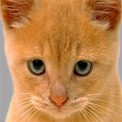For cats, life in close proximity with humans (and other animals kept by humans) amounts to a "symbiotic social adaptation" which has developed over thousands of years. Cats may express affection towards their human companions, especially if they imprint on them at a very young age and are treated with consistent affection. Some breeds like the Bengal, Ragdoll, Pixie-Bob, Ocicat and Manx are known to be very social by instinct.
Cohabitation With Pet Cats and KittensOne may see natural house cat behavior by observing feral domestic cats, which are social enough to form colonies. Each cat in a colony holds a distinct territory, with sexually active males having the largest territories, and neutered cats having the smallest. Between these territories are neutral areas where cats watch and greet one another without territorial conflicts. Outside these neutral areas, territory holders usually aggressively chase away stranger cats, at first by staring, hissing, and growling, and if that does not work, by short but noisy and violent attacks. Despite cohabitation in colonies, cats do not have a social survival strategy, or a pack mentality. This mainly means that an individual cat takes care of all basic needs on its own (e.g., finding food, and defending itself), and thus cats are always lone hunters; they do not hunt in groups as dogs or lions do.
Pet Cat / Kitten HygieneCats are known for their fastidious cleanliness. They groom themselves by licking their fur, employing their hooked papillae and saliva. As mentioned, their saliva is a powerful cleaning agent and deodorant. Many cats also enjoy grooming humans or other cats. Sometimes the act of grooming another cat is initiated as an assertion of superior position in the pecking order of a group (dominance grooming). Some cats occasionally regurgitate hairballs of fur that have collected in their stomachs as a result of their grooming. Longhaired cats are more prone to this than shorthaired cats. Hairballs can be prevented with certain cat foods and remedies that ease elimination of the hair and regular grooming of the coat with a comb or stiff brush.
Pet Cat / Kitten ScratchingCats are naturally driven to periodically hook their front claws into suitable surfaces and pull backwards, in order to clean the claws and remove the worn outer sheath, as well as exercise and stretch their muscles. This scratching behavior seems enjoyable to the cat, and even declawed cats will go through elaborate scratching routines with every evidence of great satisfaction, despite the total lack of results. Some researchers believe this is due to scent glands located in their pads, and that scratching is effectively a part of marking territory.
Pet Cats / Kittens Fondness for HeightsMost breeds of cat have a noted fondness for settling in high places, or perching. Animal behaviorists have posited a number of explanations, the most common being that height gives the cat a better observation point, allowing it to survey its territory and become aware of activities of people and other pets in the area. In the wild, a higher place may serve as a concealed site from which to hunt; domestic cats are known to strike prey by pouncing from such a perch as a tree branch, as does a leopard. Height, therefore, can also give cats a sense of security.
Pet Cat / Kitten Waste and Litter BoxIndoor cats are usually provided with a litter box containing litter, typically bentonite, but sometimes other absorbent material such as shredded paper or wood chips, or sometimes sand or similar material. This arrangement serves the same purpose as a toilet for humans. It should be cleaned daily and changed often, depending on the number of cats in a household and the type of litter; if it is not kept clean, a cat may be fastidious enough to find other locations in the house for urination or defecation. This may also happen for other reasons; for instance, if a cat becomes constipated and defecation is uncomfortable, it may associate the discomfort with the litter box and avoid it in favor of another location. A litter box is recommended for indoor-outdoor cats as well.
Daily attention to the litter box also serves as a monitor of the cat's health. Numerous variations on litter and litter box design exist, including some which automatically sift the litter after each use. Bentonite or clumping litter is a variation, which absorbs urine into clumps, which can be sifted out along with feces, and thus stays cleaner longer with regular sifting, but has sometimes been reported to cause health problems in some cats.
